The Famous, Infamous and ‘Who?’
Many strangely interesting characters and a couple of Historic Figures are associated with Lea Bridge and surrounding areas. Let’s get the historic figures out of the way first. Although I never met them and you may think that they have no place in my memoirs, I feel I should include them - just to add a bit of culture to these otherwise uncultured ramblings.
I will start the name dropping by mentioning none other than a King of England, Alfred the Great. Alfred, or Alf, as he was called in Hackney, in his efforts to thwart the invading Vikings, waited until they sailed up the Lea in search of booty, and blocked the river to hinder their return to the Thames. This dam, as well as giving the Scandinavian marauders a headache, drained the surrounding wetlands and formed Hackney Marshes. Thanks Alf!
Another famous, or should I say infamous character, not usually associated with Hackney, was the notorious Dick Turpin! This highwayman, robber and general ne’er do well, held up many a coach in Lea Bridge Road. He is generally known for operating outside of London, mostly in Essex and further afield, but a lot of his ‘dealings’ were in the East End.
When he retired from his life of crime, he went into legitimate-business and settled down in a house that was on Hackney Marsh. The house stood just past the end of Homerton Road, near the river and The White Hart pub. All this is now swallowed up by the Olympic Park and the motorway, But judging by the prices asked for admission to the games, Dick’s spirit is still haunting the Marshes!
The heading ‘Famous’ is covered by local boy made good Anthony Newley. Actor, singer, pop star, songwriter and husband of Joan Collins (who wasn’t?) he was born and lived in Oswald Street and a lot of the older people remember him before fame and fortune whisked him off to pastures new!
May Nelson
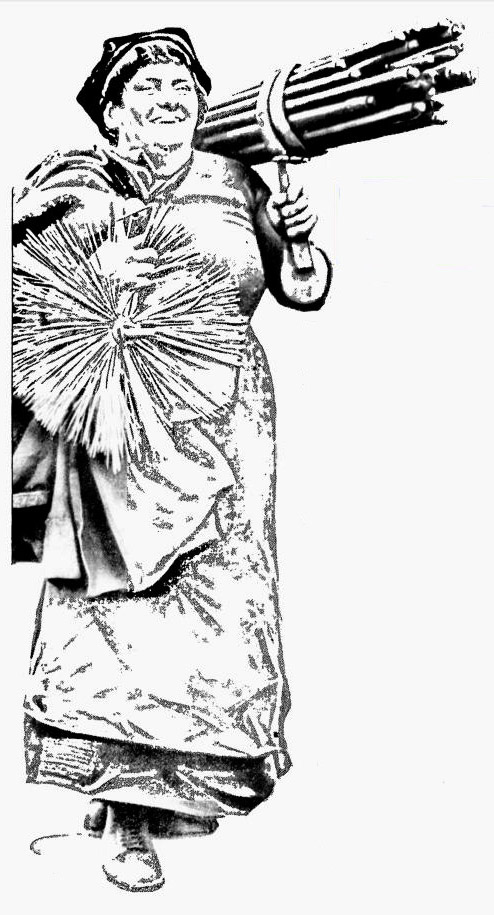 Once well known and now forgotten, our next character has a story so strong that a film or possibly a West End Musical could be written about her. May Nelson lived in Hammonds Cottages on Middlesex Wharf and was a near neighbour of the Walker Family and was legendary in East London and it appears in a vast part of the world. I do have my own memories of her but it is my Dad’s tales that have fixed her firmly in my mind.
Once well known and now forgotten, our next character has a story so strong that a film or possibly a West End Musical could be written about her. May Nelson lived in Hammonds Cottages on Middlesex Wharf and was a near neighbour of the Walker Family and was legendary in East London and it appears in a vast part of the world. I do have my own memories of her but it is my Dad’s tales that have fixed her firmly in my mind.
Let’s start this dramatic tale of love and sacrifice at the beginning. May, born in Hackney was, when young, considered a beauty. As a young girl she entered the theatrical world. She played the Music Halls of London with a lot of success and Pantomimes with even more success. She met, fell in love and married Tom Nelson, a fellow artiste. Tom was an acrobat and contortionist and was much sought after, apparently a big favourite in Sweden and Norway. They both worked in America for a time. Life for them was good, bringing with it the rewards of success. They remained happily on Middlesex Wharf, enjoying their celebrity status. World events, the 1st World War and the popularity of the Cinema, affected their success and their income, so Tom became a chimney sweep when theatre work was slow. The Chimney business thrived and life became settled again, when disaster struck. Tom suffered a stroke and his chimney sweeping days were over. May was made of stern stuff and simply took up the brushes and carried on the business. “I knew how to use the brushes” she said, “after all I had seen Tom use them enough times”.
May was now a celebrity again, as the only woman Chimney Sweep in Britain, and decided to seek further fame by becoming a professional Boxer. Her title was now Britain’s only female Chimney Sweep and Pugilist. As such she exploited the novelty of the title, appearing in newspapers, magazines and even on the popular current affairs radio show ‘In Town Tonight‘But it seems that the world was not ready for women boxers and another ambition took a nose dive.
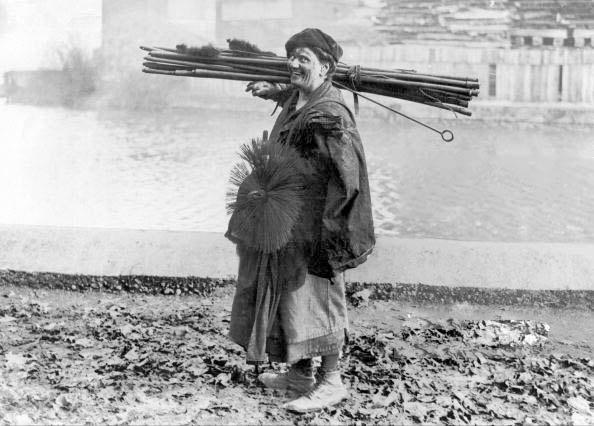
Sadly, tragedy struck again, the love of her life, Tom, died and with him went a lot of May’s self respect and dignity. She carried on the chimney sweeping, but became unreliable, dishevelled and quite honestly, rude. She took to drinking and became more and more eccentric. She seldom changed out of her working clothes-and failed to wash after sweeping chimneys, going straight into the pub complete with soot covering her clothing and face. Saddest of all, her neighbours shunned her. If anyone was dirty or had not washed they were said to be ‘as dirty as May Nelson’ My Dad often told us that she entered the pub with a black face and as she swallowed the pints, the beer that ran down her chin would wash that part of her face, giving her a scary appearance.
He told of a time when a boozy stranger came into the pub and on seeing this dirty, odd and pathetic woman, thought it would be funny to insult her and call her names using swear words. This stupid fellow never knew that he had picked on ‘The Champion Female Boxer of Britain’, but soon found out the hard way when May landed a right hook on his chin sending him straight into the arms of Morpheus!
I last saw May when I was very young, by now her sight was weak and she stumbled along the road, obviously in discomfort. I was with my Mum, and in her usual caring manner, Mum said “Mrs. Nelson, do you need a hand?” May mumbled some insult but Mum took her home anyway.
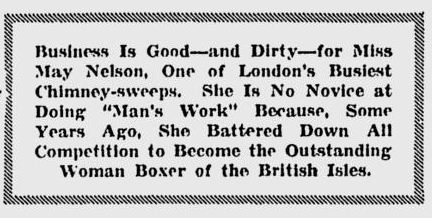

Indian Pete and Woggles
When I refer to the Marshes I mean the large stretch of country-like land that stretches from Hackney Wick to Springfield Park. Officially the land south of Lea Bridge Road is Hackney Marshes and to the north, Leyton and Walthamstow Marshes, but to the whole area was simply known as The Marshes.
The area then was a haven for wildlife, many species of birds, animals and reptiles lived or rested on this small wilderness. Sometimes, added to these native creatures were a number of exotic species, the result of impulse buying at the Sunday Morning animal market at Sclater Street, Bethnal Green. Small mammals, reptiles and birds from foreign places appealed in the shop, but when in the punters home, brought home the reality and complications of feeding and caring for such specialist pets, so it seemed the best thing to do was to ‘let the creatures go’ on the Marsh.
Goldfinches, Greenfinches, and native birds of many species abounded, I can recall seeing swarms of Yellowhammers alighting in the clearings and hearing cuckoos in the spring and skylarks in the summer. Rabbits ran around, and the ditches and streams held many fish and newts. At the beginning of the war, ditches were dug in lines all over the Marshes to prevent enemy aircraft landing. These ditches filled with water and teemed with wildlife and waterfowl. Many horses grazed freely, sometimes straying into the streets and even Lea Bridge Road, causing traffic chaos. In the summer we would ride these steeds, sometimes into the river, we really thought that we were Cowboys!
Where you find cowboys you will find Indians and Trappers, and that’s where Indian Pete and Woggles came in. Pete really did look like an American Indian, with dark skin and hawk like features and Woggles wasn’t far from a trapper with a ruddy outdoor complexion and a steady, sure, eccentric manner that made him seem to us like a mountain man. Of course, our diet of exciting western films and our healthy imaginations, helped to convince us that they were true wilderness drifters.
They were not a pair, but two individuals with the same strange lifestyle that brought them together frequently. If you didn’t know you, would think that they lived on the Marsh, because any time you went into the Triangle field, near the Chingford to Liverpool Street railway line, you were bound to find one or the other of them. A small fire smoked idly and one of them sat staring into the embers as if figuring out their next hunting raid. Sometimes a shotgun was in evidence and a rabbit dangled from a fence post.
Woggles had a reputation for being reckless, seeing no fear in guns and explosives. At Temple Mills, Leyton, was the biggest railway marshalling yard in Britain, distributing goods to every part of the country, the trains passing the Triangle every time. If another train joined the line from a different direction, the goods train would have to stop and wait until all was clear before proceeding. This short stop would give an opportunity to any one with the inclination, to jump the goods wagon and frantically throw the nearest crate onto the grass embankment, never knowing what was in it. This daring game of lucky dip produced a varied array of contraband, some highly desirable, some interesting and some simply mystifying! Valuable goods just melted away, and if no use could be found for them, they were dumped! Anything chemical, explosive or just interesting would spark an idea in Woggles’ mind, some ideas almost verging on the genius, some absolutely raving mad. Once, he removed the explosive from some ammunition and packed it in a tin and somehow manage to blow a telegraph pole that was lying on it’s side about fifteen feet into the air. We all stood at a safe distance away from the impending blast trying to look like we were not at all nervous, when Woggles, who was on his hands and knees fiddling, or should I say ‘adjusting’ the charge, jumped up and, in a frenzied flight from the experiment, fell flat on his face in the long grass of the Triangle. The bravado we displayed disappeared immediately as we followed Woggles example and dived into the undergrowth. The ear shattering blast sent the pole straight up into the air and it seemed to stay there for a minute or so while we lay in the greenery trying to guess which way the deadly missile would return to earth. It landed back on the field without managing to maim any of us, causing our bravado to return and sending us all into gales of nervous laughter. Woggles sat impassively, staring at the hole in the ground in an almost scientific way, as if all had gone to plan!
Another time, some gas cylinders and very large ‘Air Ministry’ weather balloons were the ingredients for a daring escapade. One of the enormous rubber balloons was inflated with the unknown gas, Woggles discovered that the gas was lighter than air, and if not held down, the balloon would float into the stratosphere. He studied the situation, puzzled as to what to do with these fascinating creations, when suddenly he saw the light and with a determined look on his face, left the Triangle and ‘moseyed’ home. He returned with the same faraway look on his face, giving nothing away, just like a true mountain man. In his usual steady way he fumbled in his pocket a withdrew a coil of fuse wire, the sort that was used to fire up model airplane engines, and fixed it to the neck of the balloon. With some inborn knowledge of this sort of thing, calculated just how long the fuze wire needed to be. With a leaky old petrol lighter, he ignited the fuze and with another ‘scientific’ calculation released the balloon.
Once the balloon had reached the height of ten or more feet, we breathed a sigh of relief, safe in the knowledge that the deadly mixture of gas and fire was as far away as it needed to be not to harm us, We watched the soaring danger slowly ascend into the sky, all the time wondering if Woggles really did have some ability, when suddenly a large ball of flame burst in the air high above the marshes. It was quite spectacular and we just knew that the Police, Fire Brigade and possibly the Army would descend upon us and throw us into the Tower of London and charge us with Treason or something equally as bad.
Not a soul appeared to have even spotted the display so Woggles decided that a night time ascent would be more spectacular. Every night that week a series of fiery explosions lit the dark heavens over the marshes until all the gas and balloons were used up! The combined forces of London never seemed to notice or care about this frightening spectacle!
Indian Pete roamed the wilds of the Marshes for years, always retaining his quiet distance, just like the native American trapper he longed to be. I often wonder if he has gone to his Happy Hunting Ground and is forever drifting the heavenly wilderness!
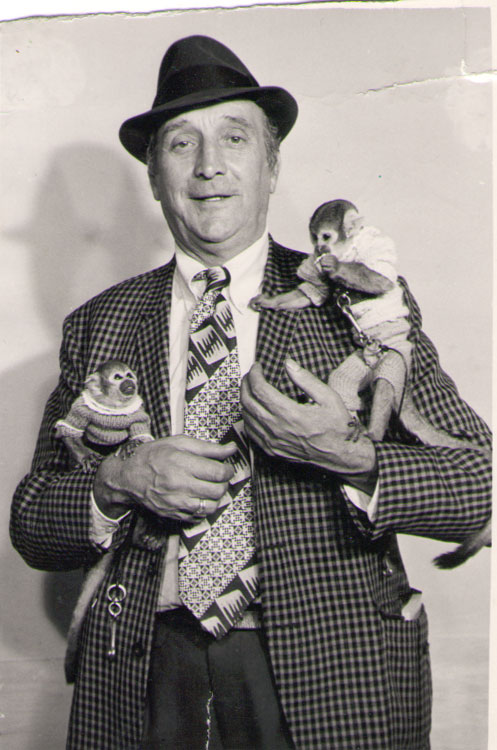 Biddy Amor
Biddy Amor
It’s not a question of what to say about Biddy, more a question of what not to say. He was a neighbour of ours along with his wife Rene and kids Jeannie and Danny, our two families being very close.
When we were small kids we were in awe of Biddy, because he wore suits with wide shoulders, a wide brimmed trilby and a wide colourful tie, just like the gangsters we saw in the American films that we watched most weeks. All this wideness is probably where the expression ‘wide boy’ comes from.
He had a strong, tough look about him, in fact as a young man he was a professional boxer, fighting in the local fight leagues under the stage name of Eddy Conway. His toughness made all us kids somehow feel protected, if anyone gave us aggro, in our minds Biddy would go and bounce them out of the area. His broken nose only added to his flamboyant good looks, and his infectious smile could charm the birds from the trees.
He had charisma by the bucketful and bags of ‘guivre’. If you don’t know, guivre is Yiddish for cockiness or you might say flashness. We all wanted to be like him, trying to copy his self confident way of walking. Of course he was a bit of a heart throb for the local women, as well as an inspiration for the younger men.
I never knew what he worked at, he seemed to always be at home. He was able to drive a lorry, another reason for our admiration, and now and then a large motor of some kind would be at his disposal, I remember him coming home with an open backed lorry which he parked in our road watched by all us boys with mouths wide open. He was no fool, he knew of our hero worship and casually turned to us and said “Go on then, jump on !” We didn’t need telling twice, we played all the afternoon in this monster of the road, only going home when our Mums called us in for Tea .
His unorthodox work pattern was broken at least a couple of times when he ‘went away’ only returning when he had served his time, as kids we were not allowed to ask why he had not been seen for a time!
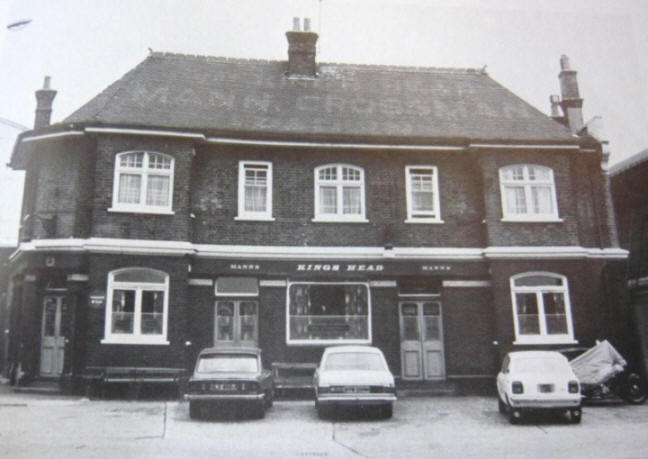
The Kings Head in the 1970s
The King’s Head pub in those days was the centre of entertainment, singers and musicians doing a turn on the weekends, making these wonderful variety evenings a magnet for the best of East End talent. Biddy, before long became the compere, adding his mixture of cheek and charm to the extremely popular proceedings. One regular performer was a local bloke called Robinson, I think, he had an extraordinary and unusual voice, a falsetto, his speciality being the songs of Gracie Fields. He would reach impossibly high notes for a man during his rendition of “Sally”. One night a bit of bad feeling was evident, later in the week I was walking through Millfields when I spotted Biddy walking in his usual cocksure manner. Coming in the opposite direction was Robinson, he of Gracie Fields fame. He walked right up to Biddy and said “So you think that I am a poof do you?” It seems that Biddy was accused of saying this, a few words passed back and forth and it was decided that they would have a ‘straightener’. A straightener is a working class duel, with rules and good behaviour expected.
The pair stepped from the path and onto the grass, removed their coats and shook hands; a couple of blokes who were passing by ‘held the coats’ or as they said, ‘saw fair play’. Punches were exchanged, no-one getting knocked down; surprisingly old Gracie Fields could handle himself and gave the much fancied Biddy as good as he got. After a short time they both felt satisfied and stopped punching, they both examined each other for injuries, shook hands and carried on doing what they were doing before the chance encounter.
Biddy’s extrovert character and sense of humour served him well and he was asked to compere in many east end pubs, clubs and seaside holiday camps, he worshipped the great comic Max Miller and would tell his jokes at the drop of a hat, he fetched the cream of pub talent to the King’s Head, making it a joy to visit.
Of course, this larger than life, charismatic, attractive man was the object of many a female’s fantasies and though discreet, it became known that ‘other women’ shared his charms. Poor old Rene, bit the bullet and ignored his philandering.
When he got older he took an interest in pigeon flying, inspired by my Dad and he quietened down. Rene got cancer and died - she was my Mum’s best mate so Mum kept an eye on Biddy, cooking meals for him and listening to his regrets. He developed a bad heart and had one of the early by-pass operations, I went to visit him in Bart’s hospital and found him in the recreation room sitting with (honest) a woman patient that he had ‘met’ on the ward. The old charm was still working and as he often said “My name is Amor, that’s French for LOVE!”
Janey Pepper'ole and the Great Battle of Lea Bridge
In Waterworks Lane next to the Prince of Wales pub a small Funfair stood all the year round. A couple of swing boats, a roundabout and a few stalls made up this unexciting attraction. These stalls, never more than about three in number, sold cheap sweets and seafood. I have found out recently that my Nan, Hannah Walker, had a stall before the war, selling sweets that she made herself, (of course her sweets were not in the cheap category.) Right in front of the old School House, in the kerb was a cockle stall owned by Janey Pepper’ole, I don’t think anyone knew her real name but she was called this rather questionable name by generations of locals.
Janey, who also had a seafood shop in Mandeville Street, cut a strange and somewhat creepy figure as she stooped menacingly over the cockles and mussels. She was very short with a distinctly bent back, her sinister, sometimes scowling face was not helped by a profusion of stiff whiskers sprouting from her chin. As kids we eyed her suspiciously as we passed the stall. Don’t run away with the idea that the stall was the work of some gifted artisan, far from it. This makeshift place of trade was made of a large wooden crate with pram wheels attached, the handle was two pieces of wood screwed to the sides with a broom handle spanning the gap, this broom handle was for pushing the ‘barrow’. A paraffin Tilley lamp brightly lit the stall after dark, hissing away in a comforting way and giving the cockles and mussels an attractive sheen, but accentuating Janey’s scary features.
I’m not sure when she stopped trading, she simply was not there one indistinct day without anyone noticing, I do know that when I got married in 1960 and lived in Chatsworth Road above a shop, Janey would pass by late every night on her way home from a day’s trading. We knew that it was her because we heard the squeak of the pram wheels and see the flash of her Tilley lamp as it swung from the handle of the barrow lighting up our room every time the lamp swung in our direction.
What about the Great Battle of Lea Bridge as the Hackney Gazette called it? Well, just up the road a bit, outside the British Oak, was another cockle stall run by the very popular Alf Cotton and his wife, Mary. The set up of Alf’s stall was much superior to Janey’s, more brighter and cleaner and naturally attracting a larger number of punters, due in no small way to Alf and Mary’s friendly banter. The cockles were sold by the plate, they were eaten immediately and the plate returned to be washed for the next gourmet to sample this working class delicacy.
I can only guess what caused the schemozzle, perhaps poor old Janey got the hump about the popularity and success of Alf’s stall, but accusations of the nicking of these small plates led to a confrontation between the two rivals which further led to shouting, swearing, the throwing of these precious pieces of crockery and lots of pushing and shoving and possibly a smack or two. The Old Bill parted the warring factions and soon after, all involved appeared at North London Magistrates Court to be torn off a strip and made to promise to behave in future, plus cop a small fine!
Kitty Shears
Fun-loving woman? Lovable eccentric? Stark raving nutcase? I’ll let you make up your own minds as to what category Kitty fell into. She would appear wherever there was an audience for her extrovert behaviour. Pubs, clubs, markets, shops, anywhere could be the venue for her most unusual talents. Kitty had a natural ability to make very convincing animal and bird sounds, she was also able to throw her voice, a voice that she could change at the drop of a hat. What’s more she was a fair singer.
Sometimes in a busy street she would stand looking in a shop window, minding her own business when a disconnected voice could be heard saying “Hello”, calling for help or squawking like a parrot. Passers by would look around in bewilderment, searching for the source of these strange sounds, Kitty stood concentrating on the contents of the window, giving not the slightest clue as to the perpetrator of the mysterious uttering.
Once when I was on the top deck of a bus ,unaware that Kitty was aboard, a strange strangled voice greeted everyone who reached the top of the stairs. Most strangely, the voice seemed to come from a different part of the deck each time. At first I found it amusing, but as I had no clue to where Kitty was, it became a bit creepy and I could feel goose pimples rising on my arms. Two young boys arrived at the top of the stairs to be greeted by a ghostly “Hello Boys”, They looked around but no sign of the speaker could be seen, one boy said “I must be hearing things” “Oh no you are not” the unearthly voice replied, they looked at each other and without saying a word, both tried to descend the narrow stairs at the same time in their effort to get away from the unexplained threat.
I am sure that Kitty would tour the area on pub nights, because it was not unusual for her to turn up in 4 or 5 boozers on the same night. Lea Bridge had three lively pubs, pubs that had a band and singers, and were always packed on Saturday nights. The British Oak was a little bit more sedate than the others, it had a violin in the band and an air of conformity to it. This respectability was crudely disregarded one night, when in the middle of some would be Frank Sinatra’s efforts, the double doors burst open just as if the police were raiding the gaff. There stood Kitty, arms held back, chest stuck out and neck stretched upwards. Before all of the customers of the pub had time to see what had caused the distraction, Kitty let out a magnificent cock crow “Cock-a-Doodle-Doo” she crowed, causing the whole pub to give a loud cheer and laugh uncontrollably, they knew what was to come.
Kitty marched across the room as if she owned it and stepped up on to the stage, up went the head again and we had a repeat performance of the “Cock-a-Doodle-Doo” only this time it was followed by her favourite risqué song. ‘Frank Sinatra’ beat a retreat as the saucy ditty began. “I went in a boat, The boat began to rock, I fell in the water and a fish got hold of my...Cock-a-Doodle-Doo” The audience gave her rousing cheer, she took a bow and disappeared out of the door as suddenly as she had arrived, bound, no doubt, for the next pub. That was typical Kitty.
In the late fifties and early sixties, Bingo was King and was played most nights at the Hackney Empire. The theatre was nearly always full, and was like a magnet for our Kitty, she attended most nights and the interval was filled with her unique and crazy entertainment.
Her appearances became less and less and when it was announced that Kitty was ‘not well’, genuine sadness was felt, the old Empire didn’t seem quite the same. When she died, tears flowed and a special night was put on in her memory, I’m sure Kitty would not mind me saying that Hackney had lost a genuine ‘Nutter’
 Tex Withers: The Clapton Cowboy
Tex Withers: The Clapton Cowboy
The council estate in Northwold Road that gave us the brilliant Lord Alan Sugar of Clapton also produced another celebrity who was not quite as well known as Lord Sugar but is still spoken about by people of his generation with great affection, and a little bit of disbelief.
I got to know Alan Withers when I was about 12 or 13, we formed ‘gangs’ then, just bunches of schoolboys who went on to be the dreaded Teddy Boy gangs. Alan was born with a badly deformed spine that gave him the classic ‘hunchback’ look and restricted his height to around 4 foot 6 inches. This did nothing to curb his audacity and cockiness, Alan was as flash as the rest of us and had a ready wit and was a master of backchat. I expect this was due to him compensating for his disadvantages. When we went to a local dance hall, all of us Clapton Boys would stand on one side of the dance floor. Alan’s eyes scanned the other groups of boys looking for something to criticise in order to start trouble, and very good at it he was. He once sauntered up to a large group of yobs, and spoke sneeringly to the biggest one who looked a bit upset at what he was hearing, Alan pointed in our direction and elaborated on his first statement and then kind of melted away as soon as the big bloke advanced in our direction along with his mob. During the scuffle that ensued, Alan was conspicuous by his absence. We never found out what he said, but the bruises took a week to go!
In the 50s no-one owned a car, so a coach was hired to take large groups to visit the seaside, this outing was known as a ‘Beano’. The sea was seldom seen as the Beano was one large booze up from start to finish, with the coach stopping at 3 or 4 pubs on the way to Southend, and more on the way back. On the way back from such an outing, something happened that changed Alan’s life forever!
Cowboy hats were sold in gift shops and no self respecting partaker of gallons of ale could resist buying and wearing one, as if no-one else had ever thought of it before. Alan bought one and strutted around like an east end John Wayne. In one roadside pub the band was swinging out some lively music, the compere asking for singers to step right up, Alan, who had never sung in public before, made confident by an unknown amount of beer, decided to mount the stage and ruin some golden oldie. The thought of this novice singing in the drunken state that he was in, filled everyone with a mixture of embarrassment and ridicule. The Band struck up and suddenly a rich deep country and western voice came from the throat of this pathetic little drunkard. He sang an old favourite cowboy song “There’s a Gold Mine in the Sky”, the punters in the pub stopped talking and listened to Little Alan finish the song and gave him a standing ovation. No-one knows who was most surprised, Alan or the audience, but Alan just stood there with his seaside cowboy hat on and grinned like he had never grinned before.
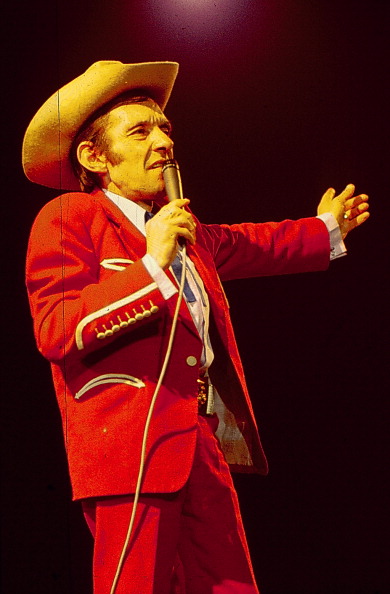
He was no longer Little Alan Withers, now he was the one and only ‘Tex Withers’. He bought a proper Stetson and a Buckskin suit and was soon earning money in pubs, clubs and Halls. Not content with dressing as a cowboy, he went the whole hog and adopted an American accent, a ‘Pappy’ in Texas and...A Horse! Most people still remember the horse because, believe it or not, the horse went on stage with him, even in the tiniest of pubs. Tex was now a minor celebrity but it seems the horse was an even bigger star. Then in the early 60s, when pub entertainment was at its height, Daniel Farson the TV presenter and producer, realised the popularity of this alternative entertainment and made a film called “Time Gentlemen, Please” that was aired on ITV. In this film was our hero, Tex, and of course his horse.
From then on Tex was taken a bit more seriously, country and western buffs recognising the authenticity of his country voice, not knowing of course that he came from Hackney. He went to Nashville and sang in “The Grand Old Oprey” the Mecca of country music, and when a Massive Event, with the world’s top country singers took place at Wembley, there was our Little Alan singing with the mighty musicians he admired so much.
A documentary was made about him, showing him cooking his food over an outdoor fire in a part of the ‘U.S.’ that looked a lot like Epping forest to me. He spoke in a slow Texan drawl and told of his dear ole’ Pappy in Texas. I didn’t see him as a trickster but as someone keeping up the old show business tradition of Hokum!
Then fate dealt him a double blow, he became ill and even worse his singing voice went, leaving him unable to earn any money. He became bankrupt, homeless and suffered from depression, I have been told that he squatted in a shack on a traffic roundabout. He found work for a while as a baggage handler at Heathrow Airport but his poor health put an end to this job. He died at 53, I guess his poor body was worn out before its time.
He still has a small following, his records are now described as collectors pieces and are often seen on ebay, but it is the legend of "The cowboy who took his horse into the pub" that lingers on.
 Since writing this tale of Tex Withers, interest in this unique character has been renewed with some unforeseen results. I go out from time to time giving talks on these stories - and it is nearly always Tex who sparks the audience’s imagination, perhaps because he is in living memory. A lot of older people say that they recall seeing him in various venues with his horse, some say he rode the horse, some say not, one bloke distinctly remembers seeing Tex, dressed all in white, riding a snow white steed at full gallop down the Roman Road into the front door of The Rising Sun and right onto the stage. I think he may be confusing Tex with the Lone Ranger! Another more down to earth neighbour of Tex’s says that he used to borrow the horse from the local ragman. I remember the ragman, Charlie, and his horse and that the horse was kept near Tex’s flat, so that is a more realistic answer.
Since writing this tale of Tex Withers, interest in this unique character has been renewed with some unforeseen results. I go out from time to time giving talks on these stories - and it is nearly always Tex who sparks the audience’s imagination, perhaps because he is in living memory. A lot of older people say that they recall seeing him in various venues with his horse, some say he rode the horse, some say not, one bloke distinctly remembers seeing Tex, dressed all in white, riding a snow white steed at full gallop down the Roman Road into the front door of The Rising Sun and right onto the stage. I think he may be confusing Tex with the Lone Ranger! Another more down to earth neighbour of Tex’s says that he used to borrow the horse from the local ragman. I remember the ragman, Charlie, and his horse and that the horse was kept near Tex’s flat, so that is a more realistic answer.
But all this was thrown out of the window by a Michael Wise, who contacted me.
He was a close friend of Tex and emphatically states that Tex was born in Texas and abandoned as a baby because of his many deformities. He also claims that Tex was a full blooded native American, ‘as you can see by his features’ and arrived in England when he was seven. After his singing career finished due to illness he married a ‘Native American woman’ who wore authentic native dress complete with moccasins and who smoked a corn bowl pipe. When I contacted Michael and said that I knew Tex as a young man and that he was a cockney Michael retorted “Bullshit! He was a native American and always had his Texan accent" Certainly many people agree with Michael, mainly, I think, because this more interesting account of our Tex’s early life had been published in some of his publicity and was in several of the obituaries carried by the National press.
I know what I remember of Tex as a teenager, but now even I have doubts of my once distinct recollections and Michael knows what he knows of Tex. It really doesn’t matter who is right or wrong because we are all enhancing the legend of one of Hackney’s more notable characters. This legend is worthy of greater acclaim than I can give it, perhaps a Blue Plaque is called for!
Lea Bridge Rock
 Lea Bridge Rock is not a mountain climbers favourite challenge, nor is it an East London form of jive music, but it is a bit of sales pitch that duped me for years. Read on for a full explanation!
Lea Bridge Rock is not a mountain climbers favourite challenge, nor is it an East London form of jive music, but it is a bit of sales pitch that duped me for years. Read on for a full explanation!
The part of the Marsh that is now occupied by the Ice Rink was scene of much excitement, pleasure and glamour. It was the ground where visiting Fairs and Circuses pitched their romantic tents! Well, they seemed so romantic to us, our hearts beat a bit faster when the first caravan arrived and set up at the front of the site. This ‘van housed the harbingers of the forthcoming mobile ‘village’ that would appear, almost out of the blue, within a week of it’s arrival.
Huge lorries, generators, trailers, caravans and large American cars piled onto the fairground, making our eyes pop from our heads and starting us to dream of being a travelling fairground Prince. Within hours, this shambolic arrival had blossomed into a magical and thrilling paradise for us young dreamers.
We always asked the showmen if they wanted any help and they always found a little job or two for us, fetching water from the tap in those shiny water cans, sweeping up, and cleaning down, it made no difference to us, our dreams of being Fairground Princes were just that little bit nearer to reality. No money changed hands as payment for our labours, but we could jump on the rides whenever we felt like it, hoping that someone was watching and thought that we were really with the fair.
My old man told me that as a boy he did the same thing and that he always worked for Old Tilly Bolesworth. “Look out for her” he told me, and I did, I found her and asked her if she knew my Dad. “Of course I do” she said, that was it, now I knew that I was a Fairground Prince, no doubt about it! It never occurred to me that Tilly was wise enough to know that her answer to my desperate question would make my fantasy come true!
When you entered the fair, the smell of crushed grass, diesel oil, candy floss and apple fritters gave the fairground an atmosphere of it’s own, the throbbing of the generators and the calling of the stallholders completed the heady mixture of sights, smells and sounds, and you knew that you were somewhere special. In the late 40s and early 50s a lot of the old time attractions were still around, Flea Circuses, Freak Shows and Boxing booths stood side by side with dancing girls, fortune tellers and coconut shies, all the traditional attractions that must have been about in the Victorian days. But the most popular pitch was slap up to date, it was a gambling game, the stall being well made, modern and stylish of it’s day. You bought a sealed ticket that when opened revealed the name of a Hollywood Film Star, the name of these stars were displayed on an illuminated board and when a wheel was spun, electrical contacts lit the names in succession, as the wheel slowed the tension built until it moved even slower and ultimately stopped on the winning name. That was thrilling enough, but for me the best bit was the selling of the tickets. A very fat, uncomfortable looking bloke would entice the punters to buy a ticket in a most persuasive manner, his rasping voice that matched his look, growled out a list of ‘Luxury’ goods that would make up the cornucopia that was the coveted prize. A large brown paper bag was placed on the table and very skillfully our sweaty host talked up the many prizes. “Three cans of the finest Canadian fruit” he would rasp, “Two cans of Luxury Salmon, Matching his and hers Top Quality Swiss watches, two slabs of American Chocolate, one pair of French Nylon Stockings, a large box of Belgian Chocolates” So it carried on until the bag was full and the last item was proudly placed at the top of the bag, “and two Sticks of Lea Bridge Rock” he called as he patted the parcel of prizes with pride. Lea Bridge Rock? Lea Bridge Rock? Two sticks of pink peppermint candy that were more at home in Southend Or Clacton, but no, they were from Lea Bridge. For years I honestly believed that they had Lea Bridge running through them. So the old rasper had used his considerable talent to fool me!
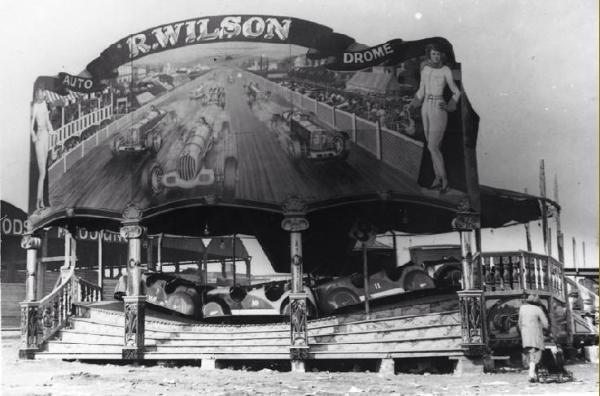
Fairground ride - Latham's timber yard visible behind
The fair often covered a vast area and spread from Lea Bridge Road back to King’s Head Bridge and beyond, and it was here that a most daring display took place. A very high ladder led skyward to a rickety platform that swayed in the wind, at the bottom of the ladder stood a small pool of water, very much like the small garden tubs we see today, when a crowd had assembled a daring young man with a cloak on, steadily climbed the ladder, always managing to somehow miss his footing causing the crowd to gasp in horror. He stood at the top staring at the scarily small pool below, when he summed up the courage, he would take off the cape and drop it from the platform, the crowd watched it float to the ground, then, just to add to the excitement, petrol was poured on the water and after much parading of the flaming torch, was ignited, causing flames to lick the ladder. Then and only then he dived, seeming to take a long time to reach the tub, and splashing out the Flames. The Crowd cheered with relief!
The rides that we liked the most were the ones that scared us, a little hint of danger somehow made us laugh hysterically, I suppose it was better than looking scared in front of your mates. The Chair-o-planes, the Big Wheel and the Whip certainly made our spines tingle, but without any doubt the biggest thrill came from the Steam Yachts. If you are not familiar with this name, they were two huge ‘swing boats’ that were shaped like giant shopping baskets that hung by their ‘handles’, side by side, from a bar. They were driven by a mighty steam engine that pumped out a uniquely smelling vapour and enabled the whistle to screech like scalded banshee, fetching punters from the four corners of the fairground to ride this massive machine. These two boats were elaborately decorated and bore the names ‘Big Bertha’ and ‘Big Lizzie’ in huge letters on their prows. If you think these names are suitable for two of your favourite old aunts, then think again. The steam engine slowly shuddered into life and the two ‘ladies’ gently swayed into action, gradually gaining momentum until they reached the frightening vertical position. We hung on for grim life inside the boat trying to look calm and collected in spite of the fact that the amplified gravity caused our heads to spin, our stomachs to turn and worst of all, our money to fall out of our pockets.

Dad and sister Eira
Once, just after we got married, me and my wife romantically took a ride on the Big Wheel, lovingly holding hands as we enjoyed the view from the top every time we reached it. When the ride was over we stepped from the ‘car’ onto the landing stage and from there onto the ground. Suddenly the Big Wheel gave a lurch and swiftly spun round the wrong way, causing the foot rest of the next car to strike the stage ripping it from the swing. In the car were two young girls, dressed to the nines, without the safety of the footrest, they slipped forward, dangling perilously. The wheel spun and lifted the screaming girls to the top of the ride where it came to a rest. The girls screamed even louder, which of course, they were entitled to, because they were in dire danger. The wheel was driven by cables and it seems a cable had slipped from the pulley, making the wheel inoperable. Many showmen and punters jumped the barrier and man-handled the wheel, in an effort to bring the girls to terra firma, but the wheel was not easy to move and the progress to the ground was frustratingly slow. The girls were now hysterical, not without reason because by now they were hanging onto the hand rail, the weight of their bodies causing their arms to weaken. The manhandling was now frantic, the rescuers working as fast as they could, then a huge sigh of relief was heard as the heroic helpers gathered the shaking girls in their arms. Then, the girls straightened their clothes, tidied their make up and asked the question “Could you see up my skirt?”
A lot of the ‘sensational sideshows’ were obvious tricks and that was, of course, their appeal, the six legged sheep was a stuffed animal with the two extra legs sewn on, and ‘The Biggest Octopus in the World, captured live by 30 men’ was a large tank with eight unconvincing rubber tentacles protruding over the top of the container, moving in a most mechanical manner, and ‘The Tallest Man In The World’ was about six foot six with 10 inch soles on his shoes and a stovepipe hat that must have been 2 feet high. However the sensation that fooled us all was without a doubt was ‘The Headless Princess’. A tall imposing man, dressed all in black, stood on a stage in front of a tent, enticing the crowds to come in and ‘see a sight that that they would not believe was possible,’ Such was his skill and personality that when the tent was opened, punters thronged in laying down the quite hefty entrance fee. Inside, when your eyes got used to the darkness, black drapes on all the walls of the tent could be seen, or perhaps not quite seen. The charismatic one from the outside, took to the stage and eerily told the expectant crowd a fantastic tale of how a Beautiful Princess of some obscure distant European kingdom was on her way to wed the love of her life, a very handsome Prince of an equally obscure kingdom, of course, when an unexpected storm, the likes of which had never been seen before, swept a giant boulder down the mountain, causing it to strike her fairy tale horse and carriage, leaving her for dead. Her head was crushed and the last rites were read, but not to worry, her Dad, the King of this obscure nation, scoured the world for a person who could could keep her Highness alive. Of course, at the very last minute a mystical doctor from an unheard of Himalayan valley arrive and decided that an extremely radical treatment was needed to save our beautiful heroine. Radical? He cut her bloody head off! Just to keep her ‘alive’ you understand.
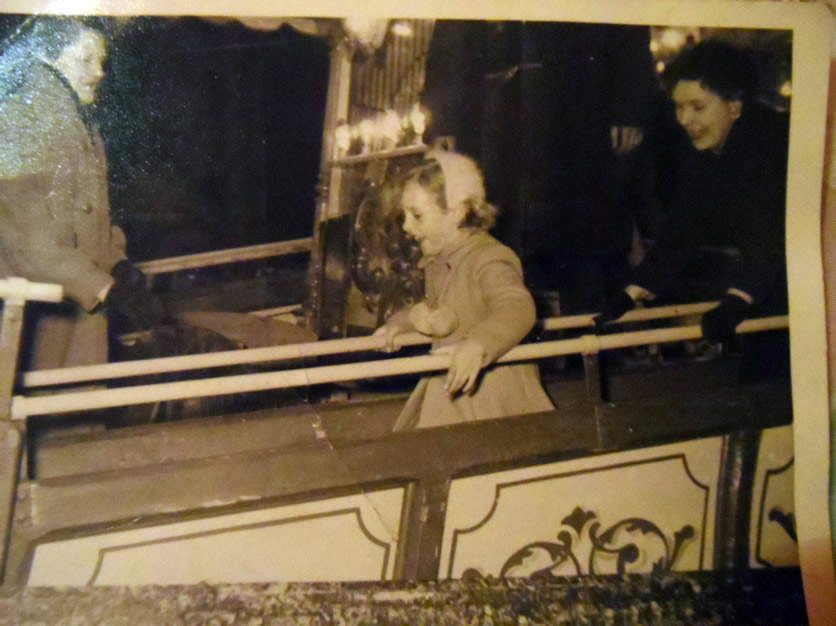
Rene Amor, Eira and Mum on the Cakewalk
At the end of his fabulous and well told story, he paused and dramatically announced “Ladies and Gentlemen, I present to you, her Highness ...The Headless Princess!!!! The dark curtains parted and there she was! A beautiful woman with beautiful legs, a beautiful figure, a beautiful heaving bosom, a beautiful gown...but no bloody bonce! She sat very regally upon a beautiful throne in a beautiful pose….but no bloody bonce!!! The stage was dressed with a black backcloth, thin smoke wafted across the stage and at each of the four corners a shiny steel tube rose and curved into the middle and all met in the place where her head should be. Mr. Charisma spoke to her Highness, of course, she never replied, “Princess, can you move your arms?”. Slowly and deliberately, her arms were lifted from the arms of the throne and swung in an artistic manner. “Princess, can you move your legs?” just as slowly, she crossed her gorgeous pins, causing stifled sniggers from the boys in the audience. “Princess, can you wish all these ladies and Gentlemen a goodnight?” The Princess gave a regal wave and the front curtains slowly closed. It was all over, the audience stood in silence, not believing what they had just seen, giving a round of applause didn’t seem the right thing to do.
Of course we knew it wasn’t true, but we wanted it to be, because we could not work out how it was done. This of course was a classic case of Smoke and Mirrors! Or was it Magic?
The Greatest Show On Earth!
Even more of a thrill than the arrival of the fair was the coming of The Greatest Show on Earth, the Travelling Circus. The fair visited Lea Bridge about four or five times a year, but the circus only pitched tent on special occasions making it a scource of joy and excitement.
Unlike the fair that arrived over a few days, the circus triumphantly paraded its way onto the marsh in a brash, glitzy, magical cavalcade that drew people from all over the East End. One moment the ground was an empty wind-blown corner of the marsh, the next - an eye popping, breathtaking spectacle of marquees, caravans, huge lorries and massive cages full of wild exotic animals.
A few weeks before the arrival, posters, leaflets, adverts in the papers and word of excited mouth hightened our already high craving to see the ‘Thrills and Spills of the Big Top’.
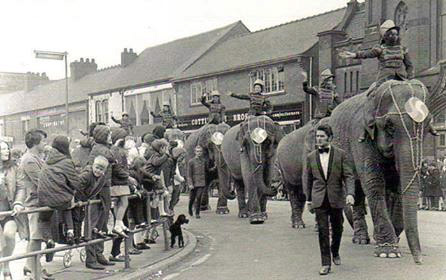 These leaflets, that we neatly folded and carefully kept in our pockets, also proclaimed in very tempting terms the coming of the Mighty Circus Parade. On the day of the parade, usually a Sunday, one or two excited kids would stand at the side of the road hours before the given time in an attempt to get a decent view. Gradually the numbers swelled until the pavements were heaving and the crowds had pushed these unfortunate early risers into the gutter. You could feel the electricity of excitement crackling along the route and when vendors walked along the kerbside selling paper wavers and trumpet-like blowers, the noise of the crowd grew into a not-so-soft bubbling. Drivers passing these crowds would blow their horns and start off an echo of hundreds of cardboard trumpets and a field of paper wavers. All this just built the tension until a loud ‘shussssh’ quietened the throng, people standing with mouths gaping, listening for the first sounds of the joy to come, and there it was, the distant sound of the Circus Band. This sound grew until the leading vehicle of the travelling pageant came into view, then the waiting, near hysterical crowd went into a frenzy of sheer delight! The wait and the crowding were well worthwhile because, as the parade drew level, we were treated to the sort of jaw-dropping, heart-beating spectacle that we had only seen before in Hollywood films. The entire parade was headed by the Ringmaster seated in the back of a huge chromium-adorned convertible Cadillac, along with two showgirls with huge feathered head-dresses making them look as tall as Nelson’s Column, when he waved the entire length of Lower Clapton Road waved back hysterically.
These leaflets, that we neatly folded and carefully kept in our pockets, also proclaimed in very tempting terms the coming of the Mighty Circus Parade. On the day of the parade, usually a Sunday, one or two excited kids would stand at the side of the road hours before the given time in an attempt to get a decent view. Gradually the numbers swelled until the pavements were heaving and the crowds had pushed these unfortunate early risers into the gutter. You could feel the electricity of excitement crackling along the route and when vendors walked along the kerbside selling paper wavers and trumpet-like blowers, the noise of the crowd grew into a not-so-soft bubbling. Drivers passing these crowds would blow their horns and start off an echo of hundreds of cardboard trumpets and a field of paper wavers. All this just built the tension until a loud ‘shussssh’ quietened the throng, people standing with mouths gaping, listening for the first sounds of the joy to come, and there it was, the distant sound of the Circus Band. This sound grew until the leading vehicle of the travelling pageant came into view, then the waiting, near hysterical crowd went into a frenzy of sheer delight! The wait and the crowding were well worthwhile because, as the parade drew level, we were treated to the sort of jaw-dropping, heart-beating spectacle that we had only seen before in Hollywood films. The entire parade was headed by the Ringmaster seated in the back of a huge chromium-adorned convertible Cadillac, along with two showgirls with huge feathered head-dresses making them look as tall as Nelson’s Column, when he waved the entire length of Lower Clapton Road waved back hysterically.
Then followed one thrill after another, beautiful spangled matching white horses, Clowns threatening the crowds with buckets of water, Trapeze Artistes showing off their muscular bodies, troupes of glamorous dancers, the Human Cannonball hanging out of the muzzle of his highly decorated cannon, The Tallest Man in the World, and most thrilling of all, cages full of Wild Lions and Tigers, a Gorilla, even a Hippo, Camels and a double decker bus with the top cut off revealing the neck and head of a rather bored looking Giraffe. Amongst these marched the wonderfully turned-out Circus Band who played their hearts out simply because they were enjoying it.
Without any doubt the most exotic and popular part of the parade was when the ‘Herd’ of massive elephants swung along the road in a string holding on to each others tails, each elephant wearing a sequined and sparkling head dress and bedecked in jewels. On the shoulders of each tusker sat another dream-like showgirl complete with towering ostrich-feathered tiara. As the elephants trundled along the road their large middles swung from side to side sometimes knocking the dense crowds that spilt out into the kerb, causing loud “Oooooh”s from the onlookers.
As the end of the parade passed by these crowds rushed into the road and followed it all along Lower Clapton Road, down Lea Bridge Road and, finally, onto the Marsh at Lea Bridge, the atmosphere was electric!
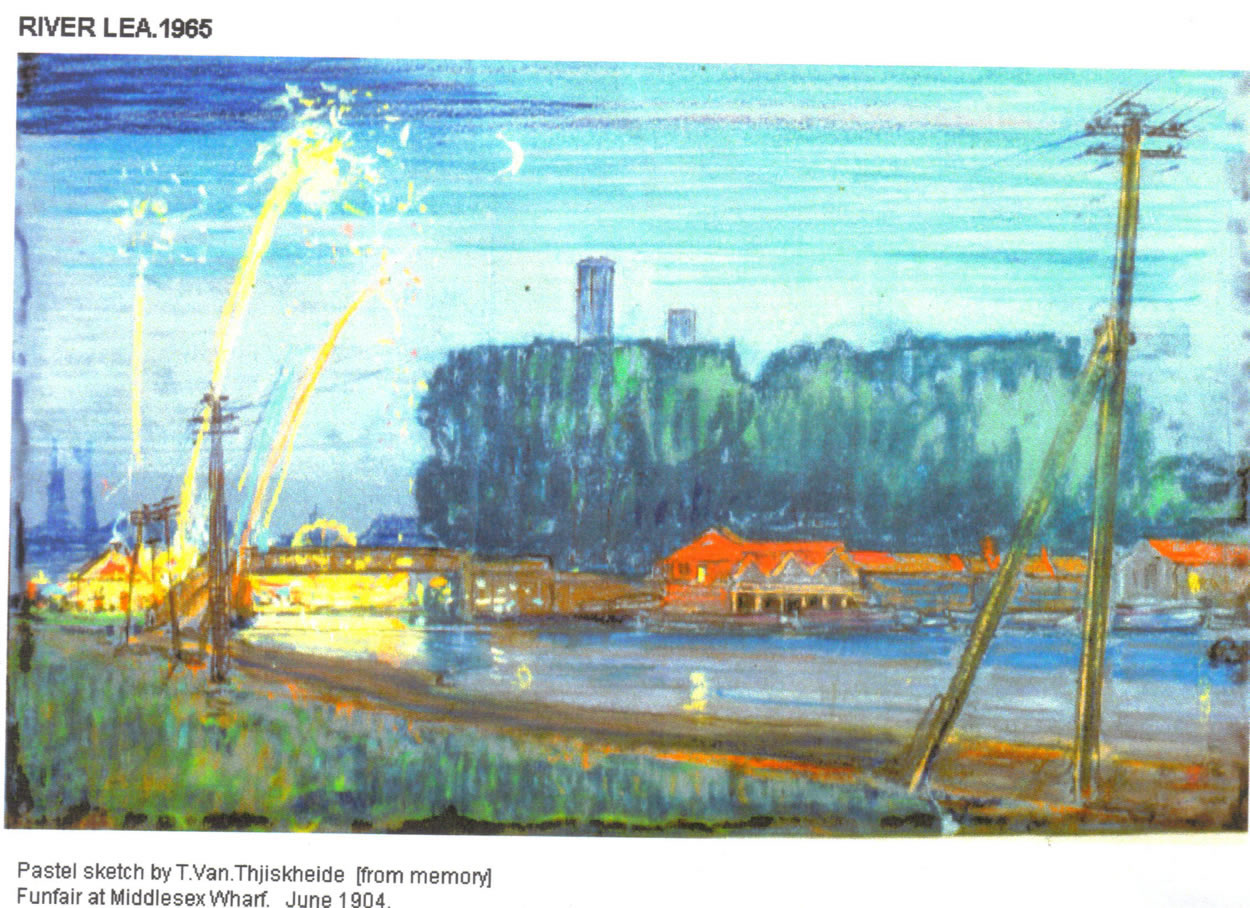 The circus stayed for two weeks giving two shows a day and drawing crowds from all over East London. Of course it was a thrilling and spectacular show, but after the dream-like parade it was time to wake up, these god-like performers were more down to earth at close quarters, the breathtaking showgirls had worn-down shoes and ladders in their tights, the daring young men were not so young or daring and the vicious kings of the jungle were somewhat sleepy. I remember watching a troupe of very beautiful trapeze artistes and being drawn to the dashing charms of a gorgeous flying athlete, her trim figure and immaculate features made my heart beat a little faster, she was captivating. That was until the interval when I went to buy an ice cream and there she was serving the wafers, her youthful looks were debateable and her fascinating face had a bent nose and buck teeth. My heartbeat returned to normal.
The circus stayed for two weeks giving two shows a day and drawing crowds from all over East London. Of course it was a thrilling and spectacular show, but after the dream-like parade it was time to wake up, these god-like performers were more down to earth at close quarters, the breathtaking showgirls had worn-down shoes and ladders in their tights, the daring young men were not so young or daring and the vicious kings of the jungle were somewhat sleepy. I remember watching a troupe of very beautiful trapeze artistes and being drawn to the dashing charms of a gorgeous flying athlete, her trim figure and immaculate features made my heart beat a little faster, she was captivating. That was until the interval when I went to buy an ice cream and there she was serving the wafers, her youthful looks were debateable and her fascinating face had a bent nose and buck teeth. My heartbeat returned to normal.
After the show we were invited into the Menagerie, a tent where the animals were kept. The ponies and horses were lovely and added to the atmosphere by providing lots of garden manure, the lions and tigers, safely locked up in heavy cages were something to wonder at, but stealing the show again were the mighty elephants. They were shackled with heavy ankle chains fixed to huge wooden pegs that were hammered into the grass, I was looking at these somewhat vulnerable pegs when one of the giants decided to let out a deafening trumpet, everyone jumped back in shock and, when his mates decided to join in the scary cacophony, the huge crowd within the marquee disappeared in a puff of smoke!
Not all visiting circuses were so affluent, the smaller, less famous ones were relegated to Millfields North and the half a dozen vehicles that they arrived in spread out around the not-so-big top in an attempt to make it look bigger. Although small, they still had ‘Wild Animals’, the elephants numbered two and were not the Jumbo-sized mammoths that they should have been and the ‘cats’ were not kings of the jungle but worn out old moggies that never had the strength to jump up on Nanny’s lap any more.
The tiny ring was perfect for the cute little ponies that staggered around it and when Captain Leo appeared complete with dashing military uniform, riding breeches and a large whip, we knew it was time for the thrill of feline danger. Captain Leo had seen better days, his lined face was covered in make up and his Errol Flynn moustache drawn on with an eyebrow pencil, the geriatric pussies looked like they could have benefited from the pencil applied in the appropriate place. The daring captain cracked the whip, waited to get his breath back and talked the cats into sitting in a roundabout then pushed the ride around until he was out of breath yet again. And so it went on and on and on.
However we did benefit from watching the elephants being led to the paddling pool near the swings on Millfields and being washed and scrubbed every day, it might have been better if we had seen Captain Leo being scrubbed in the pond!
In the early 60s I was driving very carefully down Lea Bridge Road through one of those thick smogs that we used to have, straining my eyes to see where I was going, when slowly loping out of the centre path of Millfields I made out the shape of three camels. I thought that I was letting my imagination get the better of me, but no, there they were drifting along just as if heading for some desert oasis, completely oblivious to the cold, dense fog. I was relieved that I never had a collision with them, can you imagine filling out the insurance claim form?
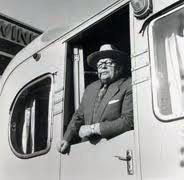 Once, the very famous Billy Smart’s Circus arrived at Lea Bridge, it was the biggest and best circus in Europe and lived up to all the hype and legendary stories that we had heard about it. Billy Smart himself set up his huge Caravan at the entrance to the site and sat on the veranda viewing his public, and waving to all who passed, he looked so grand with his trademark white ten gallon hat and a cigar as big as a chimney stack.
Once, the very famous Billy Smart’s Circus arrived at Lea Bridge, it was the biggest and best circus in Europe and lived up to all the hype and legendary stories that we had heard about it. Billy Smart himself set up his huge Caravan at the entrance to the site and sat on the veranda viewing his public, and waving to all who passed, he looked so grand with his trademark white ten gallon hat and a cigar as big as a chimney stack.
Some of the other circuses that I can remember coming to Lea Bridge were the celebrated Chipperfield’s Circus, Robert’s Circus, Lord George Sanger’s Circus and in later years, Zippo’s Circus. They still visit us, small ‘human’ circuses that squeeze onto the grass area in front of the Ice Rink. Very nice, but I do miss the smell of elephant dung!
I know that much of this is dated and not at all politically correct but we never knew about such things then, so just got on with the business of enjoying the thrills and spectacle of it. Whenever I hear the circus anthem, “ The Entry of the Gladiators” being played I still get a childlike tingle up my spine! I promise to grow up one day!
The Teddy Boy Years
By the time that I reached my teens my life had changed dramatically, I had begun to notice the difference between boys and girls, hairs started to grow in strange places on my body and my voice had lowered, this had the effect of making me think that maybe I was a man! In order to let other people know that I was now fully grown, I became a bit cocky. I spoke up more, and was thinking about perfecting the manly art of spitting on the pavement in an aggressive way, all the time forgetting that I was really a skinny, baby-faced, short-arsed kid of thirteen.
A lot of my school chums and friends were going through the same changes, so we stop calling ourselves ‘a bunch of mates’ and renamed ourselves ‘a gang’! Every street and housing estate had its own gang and we all knew one another, so it was just natural for these gangs to hang about together and go to the local picture palace and make bloody nuisances of ourselves. If we got thrown out of the cinema it really was a feather in our cap and something to brag about for weeks after. If a copper gave us a warning about our behaviour then, Blimey, there was no stopping us, that was it, we were fully fledged, dyed in the wool villains.
We wandered the streets of Hackney most nights, gazing into the many lively pubs that we were not allowed in, sitting in the coffee shops and milk bars making one cup of coffee last all evening or hanging about in Amusement Arcades, you know, those places your mum warned you about. Life was pretty comfy and cosy, that is until a gang from Hoxton wandered onto our patch and had the bloody cheek to push us about and threaten us with all sorts of horrible violence, well, we knew exactly what to do... we ran away.

Clapton Boys beano
At that time we were taking notice of fashions and styles, prior to this we wore what Mum bought us but now we were more choosey. My Mum used to buy my clothes from Perkins in Clarence Road and paid for them weekly when the ‘Tally Man’ called. Perkins sold everything from furniture to prams to tools, all crammed into a tiny shop, so the range of clothing was very narrow so we had to take it or leave it. Now was the time to leave it, giving my Mum the hump and causing her to keep on about it all the time. Early 50s styles were mostly based on what we thought Americans wore, like Billy Eckstine Collars and Tony Curtis hairstyles, but then out of the blue came a fashion that was entirely British. Now let me make something clear, the style that I am talking about was called ‘Edwardian’. and apparently it was started by cavalry officers from Chelsea Barracks and spread all over London.
The look was very traditional and tasteful and as the name implied was what is now known as retro, well made three piece suits with narrow trousers, neat polished shoes and striped ‘school ties’ giving the look an air of respectability. The drape suits with brothel-creeper suede shoes and bright socks came a lot later and came from outside of London, but soon overtook our very British Edwardian fashion. Rock and Roll, disobedience, a few quid to spend, and the open flamboyance made the younger generation resented by the previous generation, most of who had not that long before returned from running Hitler’s mighty forces out of Europe and North Africa.
Then a vicious murder at a fairground on Clapham Common by an gang of yobs dressed in the latest fashion shocked and reviled the public. These yobs were referred to in one of the more outspoken newspapers as ‘Teddy Boys’ and they whipped up their readers into a frenzy of hatred for anyone under the age of twenty. The name caught on almost overnight and the hatred followed it, ex-servicemen, who were then still young and tough, disliked these strangely dressed ‘cowards’, as they called them. It was not unusual to be challenged to fight them, an offer that was refused, mostly. I remember a railway guard at Clapton Station who started to wear his campaign medals and stand in the door of the station goading us, pushing his powerful chest into our faces.
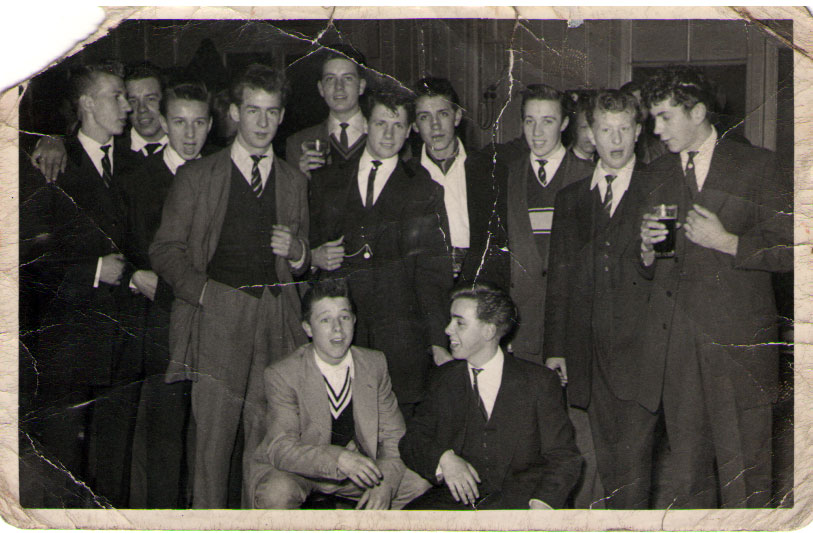
Clapton Juniors
The result of this aggression was more aggression, this time from the Teddy Boys, the gangs getting stronger and more organised. Our local group, known as the Clapton Boys formed into two chapters, the Seniors and the Juniors, and other gangs - the Pembury Boys, The Kingsmead Boys, and the Hackney Boys - liaised with us, there was even a Jewish gang at Stamford Hill, run by the notorious Moishe. Moishe’s notoriety was based on the fact that his dad was a wealthy businessman who paid for two heavies from Jack Solomon’s Boxing Gym in Brick Lane to mind him.
The Clapton Boys started a subscription fund to pay any fines that might be levied against members who had trouble with another enemy, the police. A tanner a week was paid in, and one of the boys who was a clerk entered the payment into a ledger in perfectly neat and clear handwriting. If no-one got fined then the fund would be used at the end of the year for a booze up, but one of the senior and harder boys got into severe trouble after an difference of opinion saw an opponent badly injured. Our ‘hard man’ got fined the unheard of sum of thirty quid and that was the end of the fund.
When I think back on it we never thought that we were doing anything wrong and mostly what we did was just the normal thing that young men should do, but the police and others disagreed. No-one was allowed to congregate on corners or gather in large numbers, but once, when we went to some event that escapes me now, about a hundred boys from all over Hackney met at the top of Lea Bridge Road. Of course the appearance of the crowd alerted the Old Bill, and the boys were noisy and excitable, this was a formula for trouble. We all managed to cram onto three trolleybuses just as the Hackney constabulary arrived, cheers were heard from the buses as the police vans followed us down Lea Bridge Road. We, inspired by many gangster films, said that they could not follow us over the border to Leyton, but they could! When we arrived at Baker’s Arms the local force was waiting for us and were pleased to see their Hackney counterparts. The Leyton cops had dogs with them and ordered us of the buses encouraging us along with clumps around the head and knees in the thighs, one boy got a broken foot, but no-one seemed to know how.
Many scuffles and punch ups occurred over the next couple of years and many arrests were made but I had the sense to stay clear of the police who were much more of a problem than the gangs, or could it be that we were the problem?
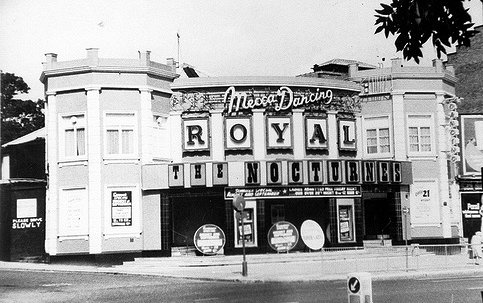 We went to all the Dance Halls in East London, big and small, Stoke Newington Town Hall, King’s Hall, Barry’s in Mare Street, the Royal Forest in Chingford, The Ilford Palais, but without any doubt the most popular one was the ‘Teddy Boys’ Graveyard’, the Tottenham Royal. This Mecca Ballroom was a touch of glamorous luxury and had the best bands. It was still the height of the ballroom dancing craze and the new-fangled, devilish Jive was frowned upon, half a dozen dinner suited bouncers saw that we did not do this disgraceful dance, that is until the section where it was allowed. We never saw ourselves as waltzers or fox-trotters so a bit of disobedience now and then was sometimes more fun than the dancing, but when looking back, our times at the Royal were the best times of our teens. One night at the Tottenham Royal a group of over twenty of us were enjoying the dancing when an announcement was made over the ‘Tannoy’. One of our number, a boy called Tony was called to the manager’s office to answer an urgent call from ‘home’ As the manager looked on, a very concerned gang member took the call, it wasn’t from home, it was from another gang from Hackney who were at a ballroom in Walthamstow and were in a ‘bit of trouble’ and needed reinforcements. Tony returned to the dance floor and told us of the situation, immediately all of us made for the door and onto the bus to Walthamstow. When twenty or so of us dreaded Clapton boys turned up to the dance hall the situation changed, the aggressive mob who were doing all the threatening melted into the vast crowd of dancers and a ‘bundle’ was avoided. Such was the dedication, the discipline and the loyalty of these highly organised gangs. One for all and all for one!
We went to all the Dance Halls in East London, big and small, Stoke Newington Town Hall, King’s Hall, Barry’s in Mare Street, the Royal Forest in Chingford, The Ilford Palais, but without any doubt the most popular one was the ‘Teddy Boys’ Graveyard’, the Tottenham Royal. This Mecca Ballroom was a touch of glamorous luxury and had the best bands. It was still the height of the ballroom dancing craze and the new-fangled, devilish Jive was frowned upon, half a dozen dinner suited bouncers saw that we did not do this disgraceful dance, that is until the section where it was allowed. We never saw ourselves as waltzers or fox-trotters so a bit of disobedience now and then was sometimes more fun than the dancing, but when looking back, our times at the Royal were the best times of our teens. One night at the Tottenham Royal a group of over twenty of us were enjoying the dancing when an announcement was made over the ‘Tannoy’. One of our number, a boy called Tony was called to the manager’s office to answer an urgent call from ‘home’ As the manager looked on, a very concerned gang member took the call, it wasn’t from home, it was from another gang from Hackney who were at a ballroom in Walthamstow and were in a ‘bit of trouble’ and needed reinforcements. Tony returned to the dance floor and told us of the situation, immediately all of us made for the door and onto the bus to Walthamstow. When twenty or so of us dreaded Clapton boys turned up to the dance hall the situation changed, the aggressive mob who were doing all the threatening melted into the vast crowd of dancers and a ‘bundle’ was avoided. Such was the dedication, the discipline and the loyalty of these highly organised gangs. One for all and all for one!
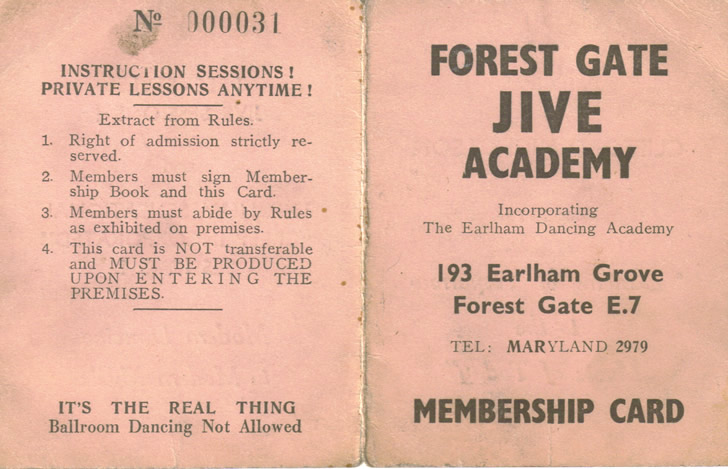 One Saturday night when we were at the Royal Forest Dance Hall in Chingford a fight broke out, we were not involved so I don’t recall much about it other than that a table full of glasses and crockery was knocked flying and glass and china strewed the floor. At the end of the night, we all walked down the hill back to Chingford Station to get the train back to Clapton, when we got to the station yard four police vans blocked the entrance and the gentlemen of the police force were grabbing all and sundry and throwing them into the vans. Not wanting to be manhandled, me and a bloke called Ronnie who came from Chatsworth Road, declined to go into the dragon’s den and walked to the bus stop which was about a half a mile away. At the bus stop was quite a queue which we got on to the end of feeling safe from any trouble. As we waited for the late bus to arrive one of the meat wagons sped past us, me and Ronnie smiled at our sensible move that avoided trouble, but the smile soon disappeared when the Black Maria screeched to a halt and reversed to the bus stop and two burly blokes grabbed us and bundled us into the back of the van. Inside the van about six or seven big, older men sat cursing and looking not at all pleased. Me and Ronnie sat in scared silence.
One Saturday night when we were at the Royal Forest Dance Hall in Chingford a fight broke out, we were not involved so I don’t recall much about it other than that a table full of glasses and crockery was knocked flying and glass and china strewed the floor. At the end of the night, we all walked down the hill back to Chingford Station to get the train back to Clapton, when we got to the station yard four police vans blocked the entrance and the gentlemen of the police force were grabbing all and sundry and throwing them into the vans. Not wanting to be manhandled, me and a bloke called Ronnie who came from Chatsworth Road, declined to go into the dragon’s den and walked to the bus stop which was about a half a mile away. At the bus stop was quite a queue which we got on to the end of feeling safe from any trouble. As we waited for the late bus to arrive one of the meat wagons sped past us, me and Ronnie smiled at our sensible move that avoided trouble, but the smile soon disappeared when the Black Maria screeched to a halt and reversed to the bus stop and two burly blokes grabbed us and bundled us into the back of the van. Inside the van about six or seven big, older men sat cursing and looking not at all pleased. Me and Ronnie sat in scared silence.
At the Cop shop, more man-handling and shouting and we were pushed against a wall and told not to move. I wasn’t too scared of the burly, heavy handed copper who did the pushing, but I was very scared of my mum’s reaction if I got home after the midnight curfew that she had imposed, so I stepped forward and told him boldly “Look mate, I haven’t done anything wrong so you can’t keep me here, I’m going!” Another hefty push convinced me that I was going to stay put by cracking my head against the wall so hard that my teeth rattled together and stars twinkling around my head.
After what seemed like hours an Inspector came and told us that we were all to be charged with ‘Insulting Words and Behaviour’ and that we could go now. It was the middle of the night and all the buses and trains had stopped so we asked how could we get home, the cocky, heavy handed copper who had pushed us about, pushed his face close to us and sneered “You can exercise the limbs that you have been using all night”. That was it, me and Ronnie started to walk towards the very distant Hackney, both of us cursing the nasty bastards who had fitted us up.
The marathon walk took hours and all the time my mind was full of the reception that my Mum would give me when I got home, the nearer that I got the tighter the knot in my stomach became. It was daylight when I arrived at Lea Bridge and as I turned the corner to home, there she was standing outside our flat with a fearsome look on her face, I just hoped that she would be able to keep her Welsh temper in check. “Where have you been?” she scowled, I opened my mouth to answer but nothing came out so I took a deep breath, cleared my bone dry throat and told her the pathetic story. She didn’t believe one word that I said, “ You must have been up to something “ she said, “They don’t nick you for doing nothing”. There followed the longest strip that had ever been torn off by anyone, then complete silence, I don’t know what was worse. The following morning the painful silence continued, that was until the radio was put on and a song of the moment was played, it was sung by Vera Lynn and the first line ‘My Son, My Son, You are everything to me’ set Mum off on floods of tears and another couple of hours of lecturing me on my many failings, Thanks Vera!
A week later a brown envelope flopped onto the door mat, it looked official and it was, it was a Summons to appear at Waltham Abbey Juvenile Court, Waltham Abbey. We didn’t even know where that was, perhaps it was near a Juvenile Prison.
The day of the hearing arrived, we stood outside the plain building that looked like a posh shed and we were called in to stand before three stiff tweedy looking members of the Juvenile board, one was a woman who had looked down her nose at me as I tried my best to look calm. The first witness was the bullying copper who had shoved us around, he never even looked at me but proceeded to tell a most fictitious tale, one where he saw me ‘shouting, swearing, pushing old people into the gutter and fighting with all the non-juvenile older, tougher hard looking blokes that we had met in the back of the Police wagon’ and to add insult to injury, I smelled strongly of alcohol.
The straight-faced magistrate in the middle of the trio asked me if I had any questions to ask the accusing copper.“Yes” I said, feeling quite bold, I looked straight at him, he looked elsewhere, “Are you sure that it was me that you saw?” “Yes” was my brief reply, “The old people that were pushed into the gutter, are they here today?” He shifted his weight onto his other foot and said “No”. “You say that I was fighting with all the other accused?” Yes”, now a bit more confident I said “When you arrested me, did I have any bruises or cuts on me?”. “No”. “But all these blokes were twice as big and twice as old as me, surely they would have beaten me to a pulp?” As I said this I opened my jacket to show my puny body, the magistrates looked at me and huddled together murmuring in some sort of agreement, I knew that they believed me, so now full of myself I launched into my most damning question. “You said that you arrested me in the Station forecourt” “Yes” “but I was never in the Station, you arrested me at the bus stop, half a mile away”. The magistrate, who I now felt was on my side, gave the copper a direct look and said “Is that true Constable?” “Yes” My heart lifted as the beak stared at him and said “How do you account for this conflict of evidence?” He uneasily shrugged and said “After I arrested him in the station, he escaped and ran to the bus stop where I re-arrested him”. The panel put their heads together and nodded as they whispered and I just knew that my courtroom skills had cracked the case.
Then the Magistrate turned to my mum and asked if she would like to say anything. I was hoping that she would tell them what a perfect son I was, how law-abiding, and what a good school and working record I had, but I should have known better. The obvious and blatant lies that had been told that day had awoken the sleeping Welsh Dragon. “Yes, I’ve got something to say, that copper is a liar, anyone can see that, everything he said was made up and if you can’t see that you should get another job. You all seem to forget what it is to be young and have a good time, look at you, you are hand in glove with the police”
I thought that the magistrate was going to explode, but he calmed himself down and said “ Thank You for letting us know our faults! We find you guilty and fine you two pounds, Next case!”
Outside of the court I suddenly found that I was no longer the juvenile delinquent that mum thought that I was, but the victim of police injustice. What a relief, it wasn’t such a bad result after all!
The territorial aggravation continued resulting in many punchups, the Hoxton Boys continued to be our biggest enemies and we all seemed to have some kind of aggression towards other teenagers who we never knew, however when we reached the age of eighteen we matured and could see the stupidity of the gang system. Then National Service found many of us serving with some of our adversaries in the biggest gang that we had ever been in and as servicemen went on to have the most fantastic adventures of our lives... but that’s another story!
THE END















